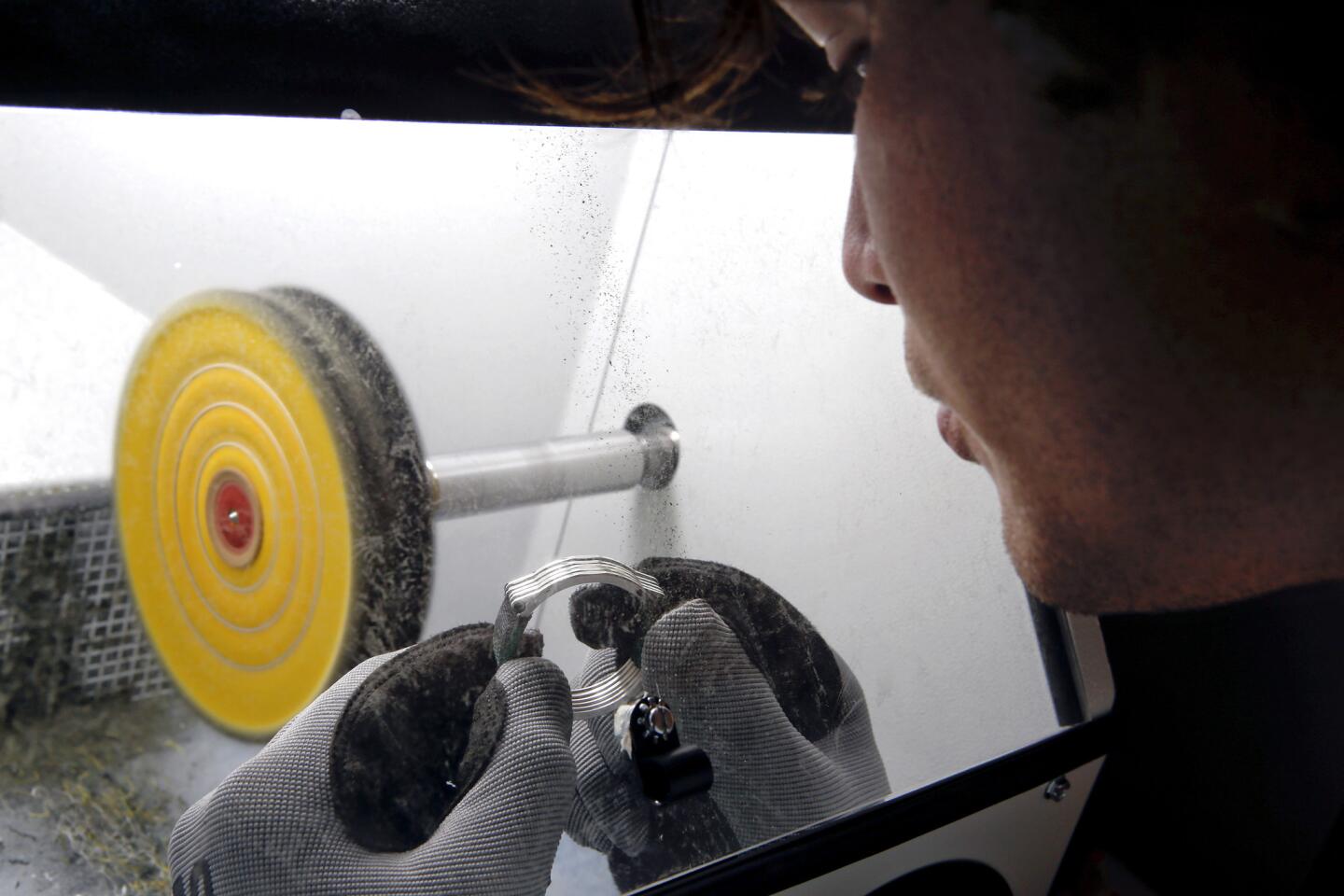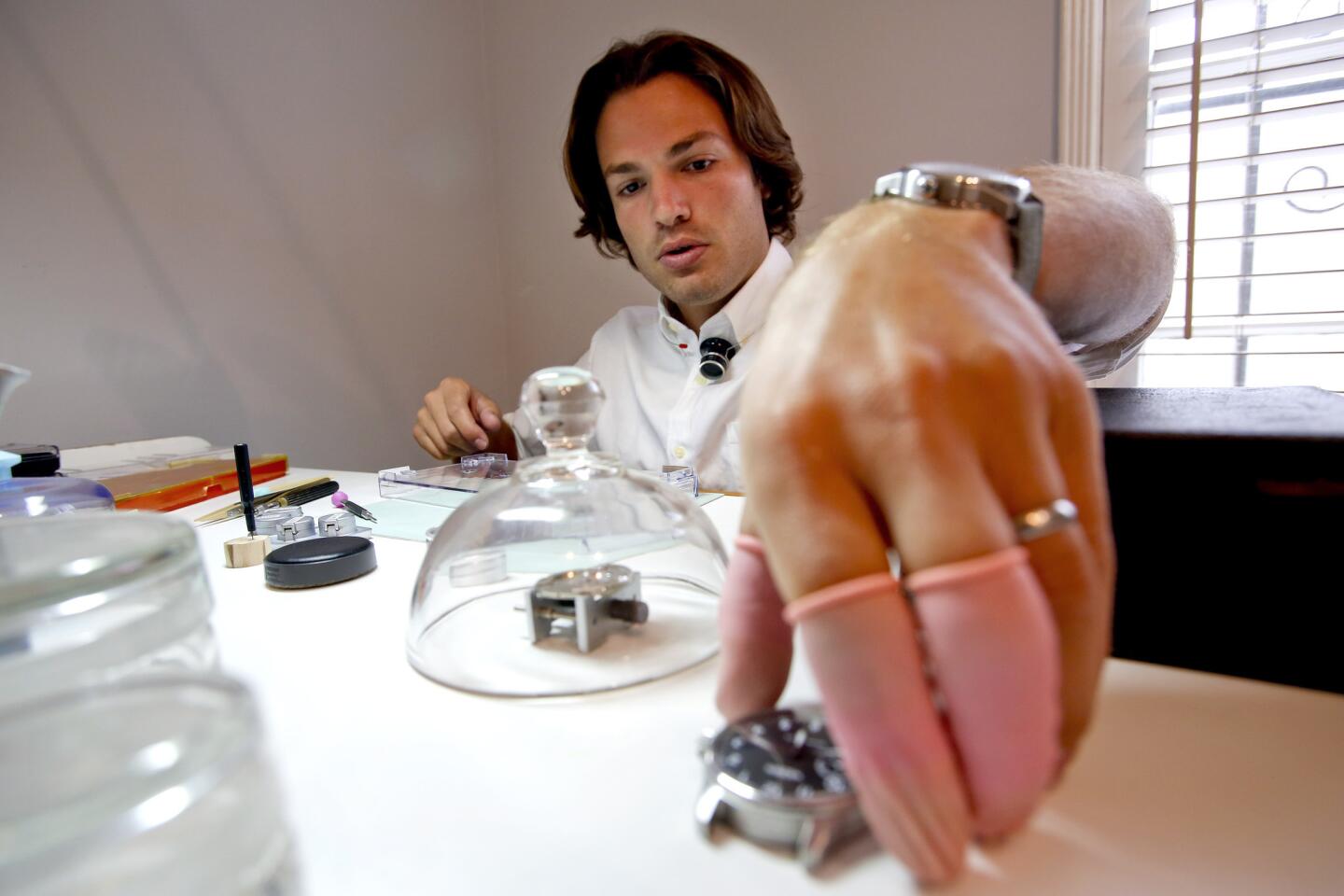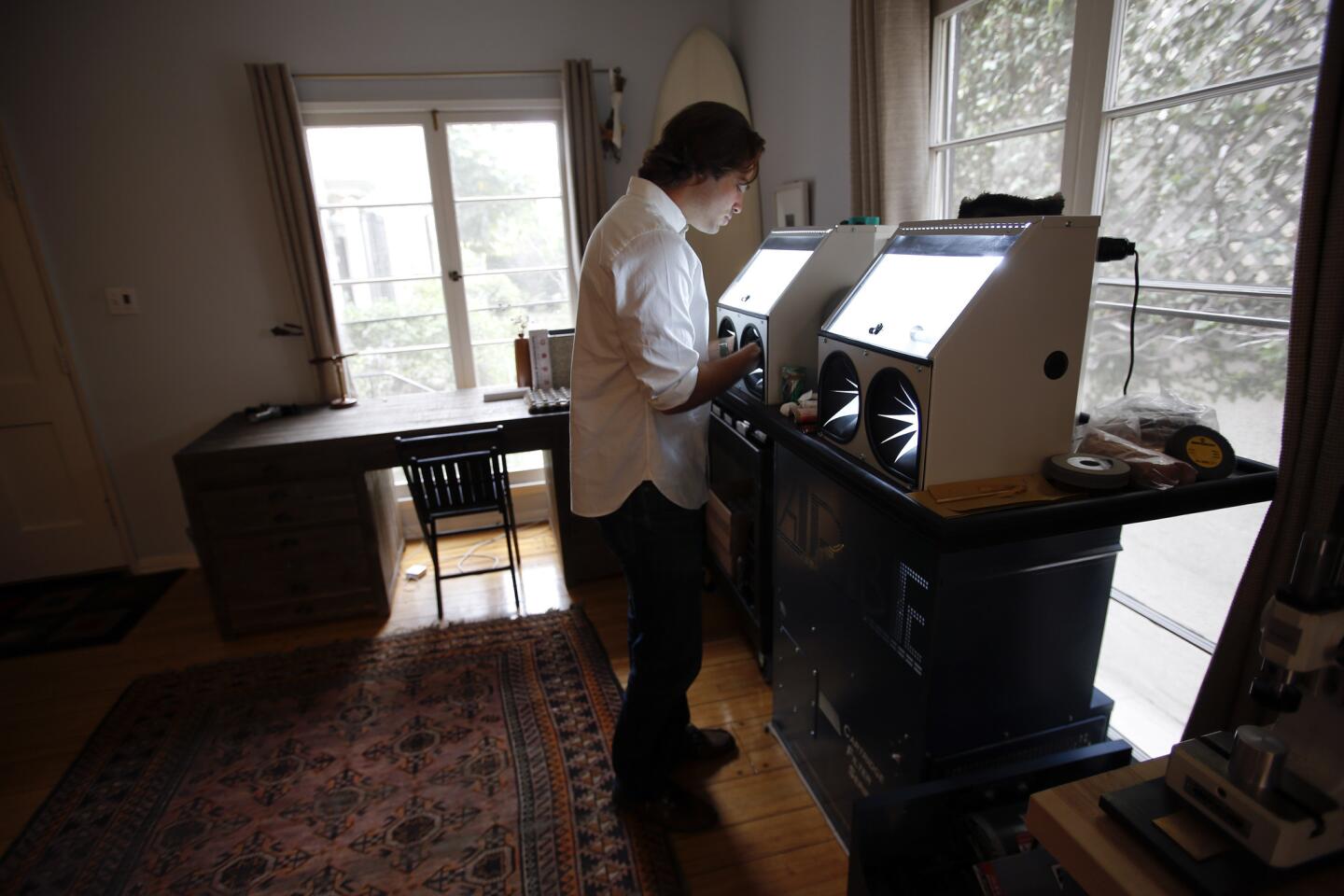Great Read: L.A. watchmaker Cameron Weiss thinks his time has come
After hand-finishing the stainless-steel case of one of his timepieces in a whirring industrial polisher, watchmaker Cameron Weiss carefully submerged it in an ultrasonic cleaning tank.
When all of the impurities had been blasted off the case, Weiss removed it from the machine — and knocked his head on a frying pan suspended from a hanging pot rack.
His cramped kitchen filled with a shrill metal clang.
These aren’t the tradition-bound halls of a Swiss watchmaking facility, and Weiss doesn’t have a graying beard, continental accent and loupe affixed to his eye.
His floppy hair, stubbled jaw and surfer’s cadence seem more frat boy than fussy craftsman. But for the last year, the 27-year-old USC dropout has been producing the only mechanical timepiece with “Los Angeles” on its dial (a detail not every watch enthusiast appreciates).
And he’s doing it from his modest one-bedroom Beverly Hills apartment, where the dining room table has given way to a workbench and the espresso machine shares kitchen countertop space with the tools of Weiss’ decidedly anachronistic trade.
The San Diego native has entered a business that clings to conventions upheld by old-school firms like Rolex and Patek Philippe, whose hand-assembled timepieces are coveted for their intricacy and beauty. And now this upstart says he’s trying to restore American watchmaking to a place of prominence?
Weiss’ love for horology — the science of measuring time — runs deep. When he was 4, he tried to fix his brother’s broken Swatch.
“His had a dinosaur on the dial, and he cracked the crystal and it filled up with water,” Weiss said. “I remember taking it apart.”
Weiss couldn’t fix the Swatch, but he was intrigued by the innards. A love affair had begun.
::
Since he launched Weiss Watch Co. a little more than a year ago, Weiss has sold about 1,000 of his Standard Issue Field Watches at $950 a pop — a far cry from battery-powered $60 Swatch watches that are regulated by quartz crystals (or Apple’s forthcoming smartwatch).
Though quartz wristwatches are popular because they keep nearly perfect time and are inexpensive, they are largely ignored by aficionados, who gravitate toward mechanical timepieces, some of which contain hundreds of parts and can cost tens of thousands of dollars — or more.
With high-end brands chasing the affluent in emerging Asian and Middle Eastern markets, the mechanical watchmaking business has exploded in the last decade.
“A lot of the new interest is from aspirational consumers,” said Kelly Jasper, contributing editor of Hodinkee, a blog covering watchmaking. “It is connected with the increase in luxury goods sales around the world, and there is still a fair amount of growth.”
It’s a business that emphasizes pedigree, of which Weiss seemingly has little. But for the most part, reviews of his timepieces commend Weiss for his bootstrapping effort, using Swiss movements but many other components fabricated by partner companies based in L.A.
Still, in some critical appraisals of the updated version of the Standard Issue Field Watch that came out in June, there are hints of damning with faint praise. An encouraging review by Hodinkee’s Jasper said the timepiece’s manually wound movement is finished and assembled to a “respectable effect.”
::
Instead of a watch for his high school graduation gift, Maureen and Alan Weiss gave their son, by then already a fanatic, $500 worth of watchmaking tools.
Cameron Weiss took the set to USC, where he studied business administration. Soon enough, he was buying broken watches on EBay and fixing them.
“It was always on my mind,” he said. “There would be times when I’d be late to class because I’d been working on a watch project. It just grew and grew, and I just started to realize that business administration — it wasn’t for me.”
Weiss knew what he wanted to do. “I am certainly not the type of person who is scared to take a risk,” he said.
In 2008, he forsook USC, leaving during his junior year. After about a year working in a Westchester machine shop, Weiss enrolled in a two-year training program at the Nicolas G. Hayek Watchmaking School in Miami. There, he received certification under the Watchmakers of Switzerland Training and Educational Program (WOSTEP) in 2011.
After a stint working for high-end watch company Audemars Piguet in Switzerland, and a short tenure with another Swiss manufacturer, Vacheron Constantin, Weiss started his own firm.
Now he’s shining watch cases in his living room, where the polishing unit rests a few feet from a cozy couch and flat-screen television. On a crowded bookcase, volumes on watchmaking share space with cookbooks.
The dining room betrays no homey touches. In the place of a table and sideboard are a computer, where Weiss designs watches using 3-D CAD software, and a 50-year-old watchmakers’ bench. Nearby, a work table holds two vintage lathes — machines used to shape metal.
Weiss’ wife, Whitney, an avid cook, has adapted, even managing to host dinner parties amid the hulking and sometimes noisy equipment.
“It is what it is, even though that’s a trite saying,” said Whitney, who is director of marketing and sales for Weiss Watch Co. “I think whatever we have to do to get what we want done is important.”
The couple celebrated their first watch sale by getting married in the Santa Monica Mountains on June 13, 2013. He wore a Weiss timepiece during the ceremony. By the end of July, they had sold 10 watches.
Today, Weiss’ watches are sold online and in about 25 specialty and clothing stores, including Barneys. But not everyone appears to be a fan of perhaps the watch’s boldest design element: the appearance of “Los Angeles” on the dial. In the comments section of Jasper’s review, some posters took issue with the designation.
One commenter wrote: “What comes to mind with the words Los Angeles? Gross excess, superficiality, and hedonistic lifestyles, not things one really wants to aspire to eh!”
::
These days, Weiss has little time for the tinkering he did as a boy.
For months, a vintage Chronographe Suisse wristwatch he’s been meaning to restore has been idling in a drawer of his workbench, its insides partly disassembled. Weiss said it would “be like therapy” if he could find the time to put the gold watch back together. For now, it will stay in the drawer.
Weiss typically works 12-hour days and often has to remind himself to eat breakfast — lest he work straight through until dinnertime. Assembly of the watches, which are made up of about 150 components, is painstaking.
“You get in this zone.... I get hyper-focused on all the little details,” he said.
Weiss has a lofty goal for his namesake firm: Within two years, he’d like to source every component for his watches in L.A. Already, the cases, dials and crowns — among other parts — are made here.
“It’s rare nowadays to find a young guy like that making watch parts,” said Dale Waite, manager of Santa Fe Springs company Louis Levin & Son, which made the lathes Weiss uses. “I respect him for getting into that field. He’s a rare dude.”
One of Weiss’ WOSTEP classmates, Ramsy Sarraff, hopes that his old classmate takes it to the European traditionalists. After all, the U.S. once had a vibrant, homegrown watchmaking industry, with companies like Elgin, Illinois and Waltham doing big business in the 19th and early 20th centuries. But by the 1960s, increased competition from the Swiss and other factors decimated the stateside trade.
“We always talk about bringing the American watchmaking industry back to compete with the Swiss,” said Sarraff, who works for Omega Watches. “You’ve got to tip your hat to the guy.”
But there are changes ahead for Weiss. As soon as the end of this month, he’ll pack up his watchmaking equipment and move the business into a warehouse property in downtown L.A.’s Arts District.
Even if there’s a bit of wistfulness in his voice when he talks about the relocation, Weiss is excited about the move.
At the very least, those dinner parties will soon feel a lot less cramped.
Twitter: @DanielNMiller
More to Read
Start your day right
Sign up for Essential California for news, features and recommendations from the L.A. Times and beyond in your inbox six days a week.
You may occasionally receive promotional content from the Los Angeles Times.














